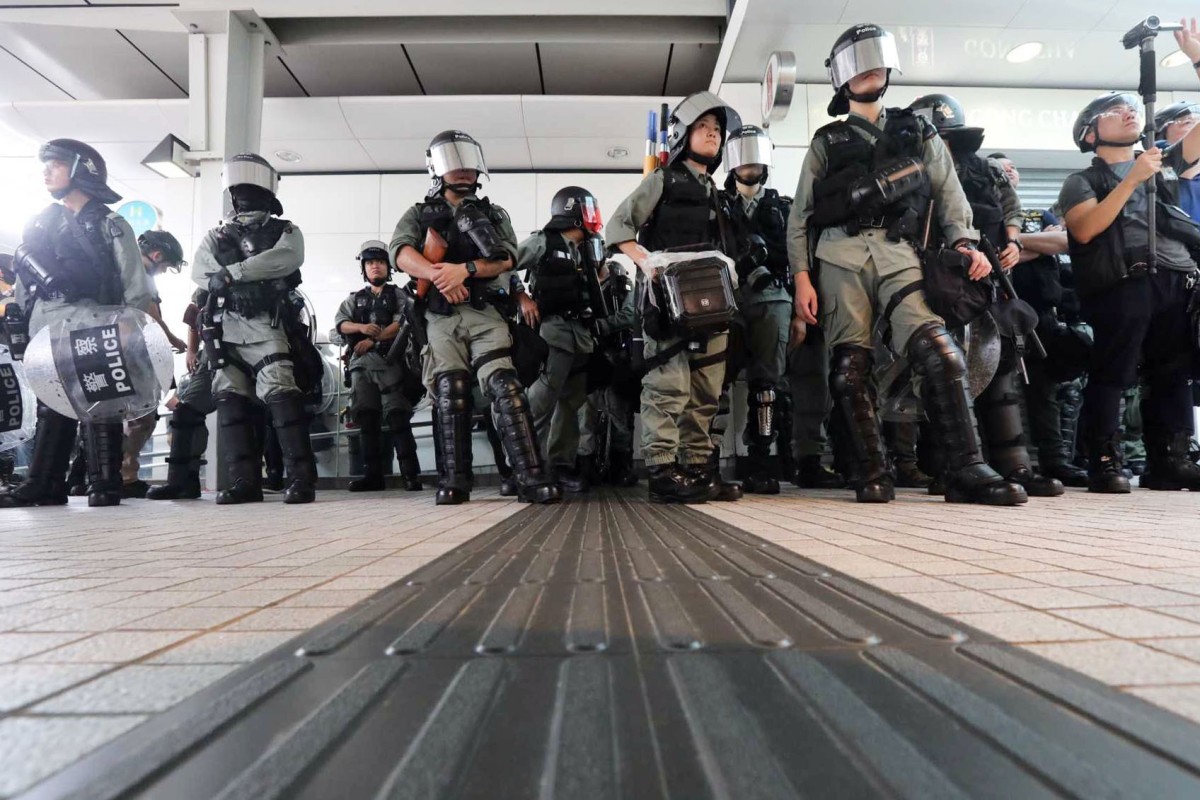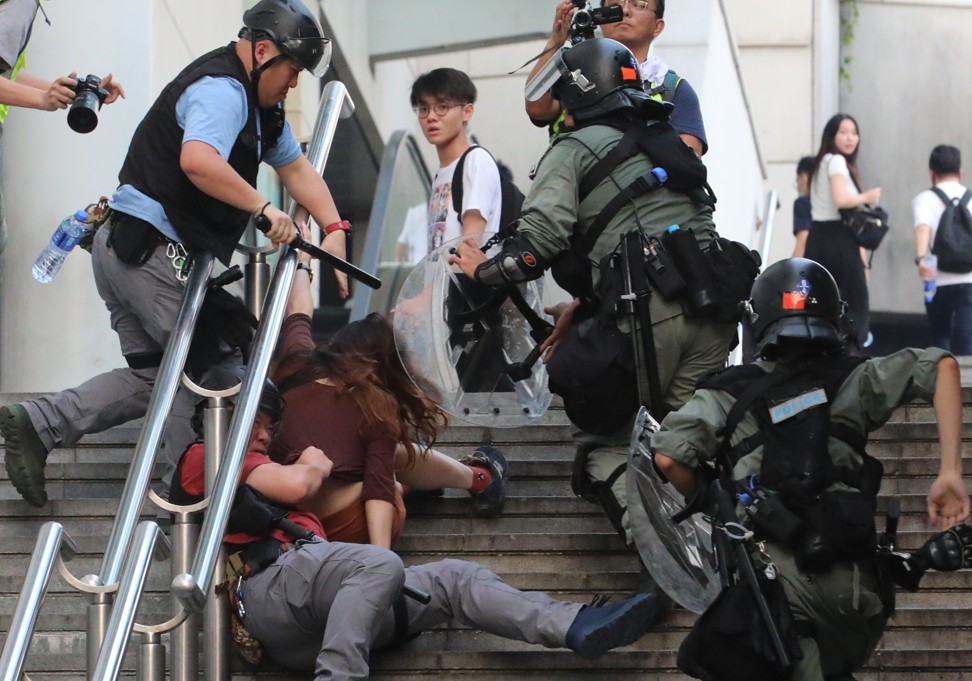Mayhem
on the streets of
Mong Kok
Tensions
flare late at night after quieter day of protest in Hong Kong
-
Bid to disrupt airport thwarted by pre-emptive police and government action, with worst violence seen late at night at Sha Tin MTR station
-
Fewer people take to the streets, days after Carrie Lam says extradition bill will be withdrawn

7 September, 2019
Fewer
protesters turned out on the streets on Saturday, days after Hong
Kong Chief Executive Carrie Lam Cheng Yuet-ngor announced the formal
withdrawal of the extradition bill that sparked the worst unrest in
the city in decades.
The
increased security prevented the chaos seen last weekend, when
protesters paralysed airport traffic and left hundreds of travellers
stranded.
That followed a separate demonstration in August, when
protesters occupied the arrivals hall, causing the cancellation of
more than 900 flights at one of the world’s busiest airports.
The
Hong Kong Airport Authority has since obtained a court injunction to
stop protests at the airport and restrict non-travellers from
entering.
No
tear gas was used and no petrol bombs were thrown at the start of the
14th weekend of anti-government protests, as the large-scale violence
seen in previous weekends was avoided. But a handful of demonstrators
were arrestedStrong pre-emptive police and government action snuffed
out the protesters’ attempt to again besiege the Hong Kong
International Airport. The MTR Corporation, the city’s main railway
operator, closed Kowloon, Tsing Yi and AsiaWorld-Expo stations on the
Airport Express line, leaving only Hong Kong station and the airport
station open, with a heavy police presence at both.
Police
also set up checkpoints on approach roads to the airport, even taking
the unprecedented step of searching passengers’ bags on buses and
trains.
The
increased security prevented the chaos seen last weekend, when
protesters paralysed airport traffic and left hundreds of travellers
stranded.
That followed a separate demonstration in August, when
protesters occupied the arrivals hall, causing the cancellation of
more than 900 flights at one of the world’s busiest airports.
The
Hong Kong Airport Authority has since obtained a court injunction to
stop protests at the airport and restrict non-travellers from
entering.
On
Saturday, with their attempt to disrupt the airport foiled,
protesters shifted their focus to MTR stations and shopping malls
owned by the railway operator. Dozens of protesters staged peaceful
sit-ins at Citylink shopping mall in Sha Tin and Kowloon Bay’s
Telford Plaza – both of which are run by the MTR – over the
company’s allowing police to enter stations and make arrests during
previous protests.

Some
scuffles occurred at Tung Chung station, which was heavily vandalised
last Sunday. But with riot police outnumbering the protesters this
time, the crowd was quickly dispersed and at least four people were
taken away by officers.
Riot
police were on standby at Tung Chung station, where there were
scuffles with protesters on Saturday. Photo: Felix WongRiot police
were on standby at
Fewer
protesters turned out on the streets on Saturday, days after Hong
Kong Chief Executive Carrie Lam Cheng Yuet-ngor announced the formal
withdrawal of the extradition bill that sparked the worst unrest in
the city in decades.
No
tear gas was used and no petrol bombs were thrown at the start of the
14th weekend of anti-government protests, as the large-scale violence
seen in previous weekends was avoided. But a handful of demonstrators
were arrested.
Strong
pre-emptive police and government action snuffed out the protesters’
attempt to again besiege the Hong Kong International Airport. The MTR
Corporation, the city’s main railway operator, closed Kowloon,
Tsing Yi and AsiaWorld-Expo stations on the Airport Express line,
leaving only Hong Kong station and the airport station open, with a
heavy police presence at both.
Police
also set up checkpoints on approach roads to the airport, even taking
the unprecedented step of searching passengers’ bags on buses and
trains.
The
increased security prevented the chaos seen last weekend, when
protesters paralysed airport traffic and left hundreds of travellers
stranded.
That followed a separate demonstration in August, when
protesters occupied the arrivals hall, causing the cancellation of
more than 900 flights at one of the world’s busiest airports.
The
Hong Kong Airport Authority has since obtained a court injunction to
stop protests at the airport and restrict non-travellers from
entering.
Some
scuffles occurred at Tung Chung station, which was heavily vandalised
last Sunday. But with riot police outnumbering the protesters this
time, the crowd was quickly dispersed and at least four people were
taken away by officers.
Prince
Edward MTR station emerged as the focal point of the protests and it
was closed in the afternoon when demonstrators started to gather. At
least 200 people surrounded the station demanding the “truth”
after rumours circulated that three – or some say six –
protesters had been “executed” by police officers inside the
station on August 31 and their bodies “whisked away”.
The
government issued a strong denial, describing the rumours as
“malicious”.
“It
is deeply regrettable that such irresponsible rumours keep spreading
with the ill intent to mislead general members of the public, and to
sow division and discontent in society at a time when the government
is sincerely trying to establish a dialogue platform,” a government
statement said.
But
the protesters were not convinced, with people placing candles,
flowers and joss paper for the “victims” – although no one knew
who they were.
Fewer
protesters turned out on the streets on Saturday, days after Hong
Kong Chief Executive Carrie Lam Cheng Yuet-ngor announced the formal
withdrawal of the extradition bill that sparked the worst unrest in
the city in decades.
No
tear gas was used and no petrol bombs were thrown at the start of the
14th weekend of anti-government protests, as the large-scale violence
seen in previous weekends was avoided. But a handful of demonstrators
were arrested.
Strong
pre-emptive police and government action snuffed out the protesters’
attempt to again besiege the Hong Kong International Airport. The MTR
Corporation, the city’s main railway operator, closed Kowloon,
Tsing Yi and AsiaWorld-Expo stations on the Airport Express line,
leaving only Hong Kong station and the airport station open, with a
heavy police presence at both.
Police
also set up checkpoints on approach roads to the airport, even taking
the unprecedented step of searching passengers’ bags on buses and
trains.
The
increased security prevented the chaos seen last weekend, when
protesters paralysed airport traffic and left hundreds of travellers
stranded.
That followed a separate demonstration in August, when
protesters occupied the arrivals hall, causing the cancellation of
more than 900 flights at one of the world’s busiest airports.
The
Hong Kong Airport Authority has since obtained a court injunction to
stop protests at the airport and restrict non-travellers from
entering.
On
Saturday, with their attempt to disrupt the airport foiled,
protesters shifted their focus to MTR stations and shopping malls
owned by the railway operator. Dozens of protesters staged peaceful
sit-ins at Citylink shopping mall in Sha Tin and Kowloon Bay’s
Telford Plaza – both of which are run by the MTR – over the
company’s allowing police to enter stations and make arrests during
previous protests.
Some
scuffles occurred at Tung Chung station, which was heavily vandalised
last Sunday. But with riot police outnumbering the protesters this
time, the crowd was quickly dispersed and at least four people were
taken away by officers.
Prince
Edward MTR station emerged as the focal point of the protests and it
was closed in the afternoon when demonstrators started to gather. At
least 200 people surrounded the station demanding the “truth”
after rumours circulated that three – or some say six –
protesters had been “executed” by police officers inside the
station on August 31 and their bodies “whisked away”.
The
government issued a strong denial, describing the rumours as
“malicious”.
“It
is deeply regrettable that such irresponsible rumours keep spreading
with the ill intent to mislead general members of the public, and to
sow division and discontent in society at a time when the government
is sincerely trying to establish a dialogue platform,” a government
statement said.
But
the protesters were not convinced, with people placing candles,
flowers and joss paper for the “victims” – although no one knew
who they were.
Kelly
Kan, 26, knelt in front of the funeral wreaths at the station for two
hours. “We want to remind people of what happened here. So far
there is no evidence or detailed account explaining what happened …
but the number of people being sent to hospital just doesn’t add
up,” Kan said.
Ten
protesters were said to be injured during a clash with police inside
Prince Edward station last Saturday, but only seven were confirmed to
have been sent to hospital. The ambulance service later clarified
that this was just a counting error, but the rumours that protesters
had been killed began to swirl.
By
nightfall on Saturday, protesters had gathered outside Mong Kok
Police Station and were shining laser pointers at police officers,
who unfurled banners warning them to disperse. The worst violence
happened late in the evening inside Sha Tin MTR station, where a
dozen protesters cornered police officers and attacked them with
umbrellas and metal objects. The officers retreated into a control
room as protesters tried to kick down the door, until the riot police
arrived to rescue their colleagues.
But
although tensions were again high at various stages of the evening,
it was less tense than previous weekends overall, and the crowds were
visibly smaller.
It
followed Lam’s announcement on Wednesday that she would formally
withdraw the extradition bill that would have allowed criminal
suspects to be sent to the mainland for trial. Many protesters vowed
to fight on until all five of their demands – which include the
bill’s withdrawal and an independent inquiry into the police
force’s handling of the unrest – were met.
But
it remains to be seen whether a quieter Saturday signals the
beginning of the end for Hong Kong’s three months of protests, or
was just a lull.
No comments:
Post a Comment
Note: only a member of this blog may post a comment.